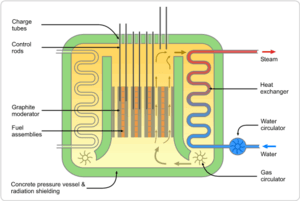Advanced gas-cooled reactor facts for kids
The Advanced Gas-cooled Reactor (AGR) is a special type of nuclear reactor used to make electricity in the United Kingdom. Think of it as a big power plant that uses heat from splitting atoms to create energy. These reactors are the second generation of gas-cooled reactors built in Britain. They use a material called graphite to help control the nuclear reaction and carbon dioxide gas to cool everything down. Since the 1980s, AGRs have been a very important part of how the UK gets its electricity.
Contents
What is an Advanced Gas-cooled Reactor?
An Advanced Gas-cooled Reactor, or AGR, is a kind of nuclear power plant that generates electricity. It's designed to be very safe and efficient. These reactors are unique to the UK and have been a key part of its energy supply for many years. They are called "gas-cooled" because they use a gas, not water, to remove heat from the reactor core.
How Do AGRs Make Electricity?
Inside an AGR, tiny particles called uranium atoms are split in a process called nuclear fission. This splitting creates a lot of heat. This heat is then transferred to carbon dioxide gas, which gets very hot. The hot gas then flows through a special boiler, turning water into steam. This steam spins a large turbine, which is connected to a generator. The generator then produces electricity, which is sent out to homes and businesses.
The Role of Graphite and Carbon Dioxide
AGRs use two main materials to work safely and efficiently:
- Graphite: This material acts as a "neutron moderator". In a nuclear reactor, neutrons are tiny particles that cause uranium atoms to split. Graphite slows these neutrons down, making it easier for them to hit other uranium atoms and keep the reaction going steadily.
- Carbon Dioxide: This gas is the "coolant." It circulates through the reactor core, absorbing the intense heat created by the nuclear reaction. This hot gas then carries the heat away to produce steam for electricity generation. Using gas as a coolant allows the reactor to operate at very high temperatures, which makes it more efficient.
History of AGRs in the UK
The Advanced Gas-cooled Reactor was developed in the United Kingdom. It was designed to be an improvement over the first generation of British nuclear reactors, known as Magnox reactors. The first AGR power station, Dungeness B, started operating in the 1980s. Since then, several more AGR power stations have been built across the UK. They have been the main source of nuclear power in the country for decades, providing a reliable supply of electricity.
Where Are AGR Power Stations Located?
There are several AGR power stations located around the United Kingdom. These large facilities are often found near the coast because they need a lot of water for cooling purposes. Some well-known AGR power stations include:
- Torness in Scotland
- Dungeness B in Kent, England
- Heysham in Lancashire, England
These stations house multiple AGR units, each contributing to the UK's electricity grid.
Images for kids
-
The two power stations with four AGRs at Heysham
See also
 In Spanish: Reactor refrigerado por gas avanzado para niños
In Spanish: Reactor refrigerado por gas avanzado para niños





